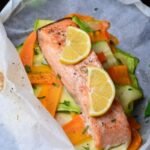Wondering how long to cook salmon? Whether you’re baking, grilling, or pan-searing, this guide provides the perfect cooking times and tips for tender, flavorful salmon every time. Learn the best techniques and get your salmon cooked just right!
- For an even cook, set your oven at 375 degrees Fahrenheit (190 degrees Celsius). Raise the temperature to 400°F (200°C) for a slightly crunchier top.
Time Required to Bake Salmon:
- Bake for approximately 12 to 15 minutes for fillets that are 1 inch thick.
- Marinate thick-cut salmon steaks in the oven for fifteen to twenty minutes.
- Steps to Verify Doneness: The salmon should be opaque throughout and flake easily when prodded with a fork. The internal temperature of cooked salmon should be 145 degrees Fahrenheit (63 degrees Celsius), but a meat thermometer will give you a more precise reading.
- Advice from the pros: To keep the salmon from burning, glaze it in the last three to five minutes of baking.
2. How many minutes should you grill salmon?
- Grilling fish provides a smokey flavour and crispy skin, ideal when cooking outdoors in the summer. If you want perfectly cooked salmon, follow these steps to grill it.
- Grill should be heated to medium-high, or approximately 375°F or 190°C.
How Long Should I Grill My Salmon?
The salmon fillets, which should be approximately an inch thick, should be grilled for four to six minutes on each side.
- I use a thickness gauge to grill salmon steaks for 6 to 8 minutes on each side or until done.
- Steps to Verify Doneness: The ideal salmon is opaque-looking and readily flakes when tested with a fork. Perfect doneness is achieved when the internal temperature reaches 145°F or 63°C.
- An expert trick is to either use a grill basket or brush the salmon with oil to keep it from sticking. For extra crispy and tasty skin, fry with the skin side down first.
- The third question is how long it takes to pan-sear the salmon to make the skin crisp and the flesh soft. This method is perfect for a simple weeknight meal because it requires only a handful of items.
- Preheat a cast-iron or nonstick skillet to medium-high heat.
3. How Long to Pan-Sear Salmon?
- Add 4-5 minutes to the grill of 1-inch thick fillets on each side.
- Add 5 to 7 minutes of searing time per side for salmon steaks.
- Steps to Verify Doneness: Flake easily with a fork and ensure the salmon is opaque throughout. Use a meat thermometer to ensure it reaches an internal temperature of 145°F or 63°C.
- The skin of the salmon will be crispier if it is cooked skin-side down for the first several minutes without turning. Make sure the pan is manageable to ensure a decent sear.
4. How Much Time Must I Broil Salmon?
Also Read:
How Long to Cook Salmon in the Air Fryer
How Long Does Cooked Salmon Last in the Fridge? Your Ultimate Guide to Freshness and Safety
Broiling is another quick cooking technique great for salmon. It’s similar to grilling, except the heat is directed upwards to get a little caramelization and crunchiness on the outside.
Setting the Broiler to High: Preheat the broiler to high, approximately 500°F, or 260°C.
Salmon Broiling Duration:
Broil salmon fillets should be thinly sliced for 6 to 8 minutes.
Broil the salmon steaks for 8 to 10 minutes and serve.
Steps to Verify Doneness: The salmon should be opaque in the middle and flake easily when pressed with a fork. It should conform to the recommended internal temperature of 145°F or 63°C.
A helpful hint: put the salmon on the upper oven rack, 6 to 8 inches from the broiler. Because broiling cooks salmon so rapidly, you must check it closely.
5. How Much Time Should I Spend Poaching Salmon?
Poaching is a technique for delicately cooking salmon in a simmering liquid, such as broth, water, or wine. In addition to imparting a subtle flavour, this technique maintains the fish’s moisture and tenderness.
- According to the recommended method, simmer the poaching liquid at 160–180°F, or 71–82°C.
Salmon Poaching Season:
- Add a few minutes of poaching time for each fillet of salmon.
- Allow 20 to 25 minutes of poaching time for salmon steaks.
Steps to Verify Doneness: If the salmon is done, it should flake easily and be opaque throughout. 145°F, or 63°C, is the target internal temperature.
Expert advice: to enhance the flavour of the poaching liquor, try adding garlic, herbs, or citrus. To prevent the fish from getting rough, simmer, rather than boil, the liquid.
6. The Perfect Time to Slow Cook Salmon
Although it takes more time than other methods, slow cooking produces delicate and tasty salmon with little to no effort on your part.
Lower the heat setting on your slow cooker.
Marinating Time for Salmon: Marinate fillets and steaks of salmon for two to three hours.
Steps to Verify Doneness: All salmon should be opaque and flake readily when tested with a fork. Use a thermometer to ensure the interior temperature reaches 145°F or 63°C.
As a pro tip, a little broth or water added to the slow cooker can keep the salmon wet. Be careful not to leave the fish in the slow cooker for too long, as it can dry it out.
7. How to Cook Salmon to Perfect Doneness
- The secret to perfectly cooked salmon is knowing when to flip it. Some ways to determine when salmon is done cooking are:
- The fish is cooked when it easily flakes when tested with a fork. The meat should fall apart into big, juicy flakes when you gently stab it with a fork.
- The salmon should become translucent to opaque during cooking. After starting a subdued orange or off-white, the hue will change to a deeper pink.
- Checking the internal temperature of the fish using a meat thermometer will yield the most precise results. According to the USDA, a temperature of 145°F (63°C) is the recommended cooking method for salmon. While cooked through, the fish is at its most delicate and succulent when served at this temperature.
8. Methods for Always Cooking Flavorful Salmon
Stay Under Cooked: Salmon tastes best when cooked, just a little underdone, as it continues to cook even after you remove it from the heat.
Get a Meat Thermometer: Whether you want your salmon medium-rare or well-done, a meat thermometer will help you get it right.
After cooking, let the salmon rest for a few minutes before cutting it into it. This maintains the fish’s moisture and aids in the redistribution of its juices.
Conclusion: Always Get Flavorful, Just-So Salmon
It’s a breeze when you know how long it takes to cook salmon in different ways. Pay close attention to the time and adjust according to the thickness of the fish and your desired doneness degree when baking, grilling, broiling, or poaching. Following these steps will ensure that your salmon is cooked to perfection every time, and you can savour a nutritious and delicious meal.
How Long to Cook Salmon in the Air Fryer
How Long Does Cooked Salmon Last in the Fridge? Your Ultimate Guide to Freshness and Safety


